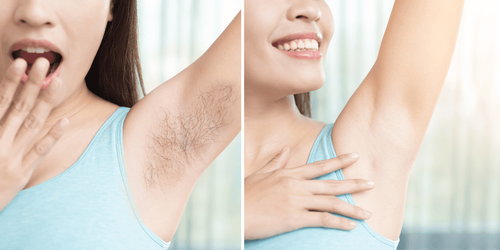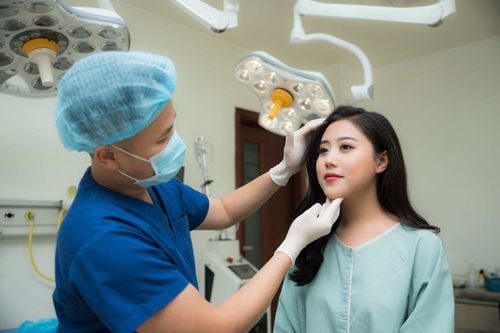Darkened underarms can be a cosmetic concern and, at times, may indicate underlying health risks. Understanding the causes of underarm darkening and learning how to address the issue can help restore confidence and aid in early detection and treatment of potential medical conditions.
1. What causes darkened underarms?
Deodorant Irritation
Certain deodorants may irritate the skin. Instead of causing a rash, like in other body parts, irritation in the underarm area often leads to darkening and itching. This is due to the tendency of body folds, such as the underarms, to develop post-inflammatory hyperpigmentation. People with darker skin tones should be especially cautious about this issue. If you notice darkened underarms, switching to a different deodorant could be an effective first step before exploring other causes.
Hormonal Imbalances
Hormonal fluctuations, such as those experienced during puberty or pregnancy, can impact skin pigmentation in various ways.
Skin darkening due to hormonal imbalances, known as melasma, occurs when melanocytes (the cells responsible for skin pigmentation) are overstimulated by abnormal levels of progesterone and estrogen. This can lead to hyperpigmentation in areas like the underarms
Hormone-related underarm darkening is most commonly seen in pregnant women or individuals using hormonal contraception. If discoloration occurs suddenly after starting a new contraceptive method or during pregnancy, it could be a cause of melasma.
Medication side effects
Several medications are known to cause underarm darkening, including:Nicotinic acid, insulin, pituitary extract, systemic corticosteroids, and Diethylstilbestrol
Fortunately, medication-induced discoloration is often harmless. However, it’s crucial to consult a healthcare professional to rule out any underlying medical conditions contributing to the darkening.
Dead Skin Cell Buildup
The accumulation of dead skin cells can lead to darker, itchier underarms. When dead skin cells build up, they can increase pigmentation, and the underarm area is particularly prone to this issue.
The solution is straightforward: regular exfoliation. Using body or facial exfoliants can help remove dead skin cells, brightening the underarm area if cell buildup is the cause.
Improper shaving practices
Shaving is a common routine for many women, but improper techniques could contribute to underarm darkening. Post-inflammatory hyperpigmentation from irritation is a frequent culprit, often caused by shaving, friction, or scratching.
In cases where shaving is the cause, the razor may irritate the skin.
The hair itself may contribute to the darker appearance, especially if the hair is darker than the surrounding skin.
Shaving only removes hair at the surface level. If the hair beneath the skin is darker, it can make the underarms appear discolored, even though the underlying issue is just the hair itself.
To prevent darkening in this case, try using an epilator or waxing instead of shaving to remove underarm hair, as these methods pull the hair from the root rather than cutting it at the surface. Additionally, consulting a doctor about laser hair removal is an option worth considering, as research has shown it to be a generally safe and effective method for permanent hair removal.
Acanthosis nigricans (AN)
Acanthosis nigricans is a skin condition that causes one or more areas of the skin to darken and thicken, often with a velvety texture. This discoloration can occur in the underarm area, as well as on other parts of the body, such as the neck, elbows, knees, or beneath the breasts. AN is commonly linked to obesity, as elevated blood sugar levels in the body contribute to the condition.
While AN itself is not contagious or life-threatening, it may signal the onset of serious health issues such as diabetes, metabolic disorders, or even cancer in rare cases. Seek medical advice if you notice darkened skin in any of these areas, especially if the discoloration appears suddenly or is accompanied by other symptoms like weight gain, irregular menstrual cycles, excessive hair growth, or other hormonal changes.
Insulin resistance
According to the American Diabetes Association, AN is often an early indicator of type 2 diabetes, where the body struggles to regulate insulin. This leads to increased pigment production and darkened skin. Consult a doctor promptly if discoloration occurs rapidly, particularly if accompanied by early signs of insulin resistance.
However, underarm darkening may not be the first visible sign of diabetes; discoloration of the neck is often more common. It's important to monitor overall body changes to detect early warning signs of health issues.
Possible cancer
In rare cases, AN can develop as a symptom of cancer, particularly when a malignant tumor grows in the stomach, liver, or other internal organs.
Darkened or discolored underarm skin can be one of the most visible external signs indicating a potential internal issue. These skin changes often resolve once the malignant tumors are removed.

2. How to prevent dark underarms
If hyperpigmentation arises from external irritation, the first step is to modify your shaving habits and possibly switch to a different deodorant.
About shaving, several factors can contribute to darkened underarm skin when shaving. For example, skipping shaving cream can cause irritation, leading to hyperpigmentation. Similarly, using a dull razor or applying excessive force while shaving can trigger skin reactions. To prevent this, consider using a new razor, applying moisturizing shaving cream, and shaving more gently.
When using deodorants, avoid those with harsh chemicals and opt for ones made with natural ingredients. Look for deodorants with minimal known irritants (such as baking soda) and replace them with skin-soothing components like glycerin. This helps reduce irritation and prevents darkening.
By making these adjustments, you can minimize the risk of underarm darkening and maintain healthy skin.

3. How to get rid of dark underarm?
If your underarms are itchy and dark, and it is affecting your confidence, you should consider methods to lighten the dark skin under your arms
A doctor may recommend at-home or dermatologist-office treatment such as retinoids, alpha hydroxy acids, salicylic acid, hydroquinone skin creams, or other topical treatments.
In addition, it is important to establish a daily moisturizing routine for this area and be gentle when shaving, using non-toxic deodorants. Less irritation leads to less pigmentation, helping the underarms recover and lighten over time.
In summary, dark and itchy underarms can be a source of discomfort and sometimes limit daily activities. They may even signal underlying health conditions. Therefore, it is important for everyone to observe any changes in the body, actively seek out causes, and address them as part of overall health and beauty care.
Be sure to regularly visit the Vinmec website (www.vinmec.com) for useful health care information and leave your details if you need advice from a doctor!
To arrange an appointment, please call … or make your reservation directly HERE. You may also download the MyVinmec app to schedule appointments faster and manage your reservations more conveniently.













